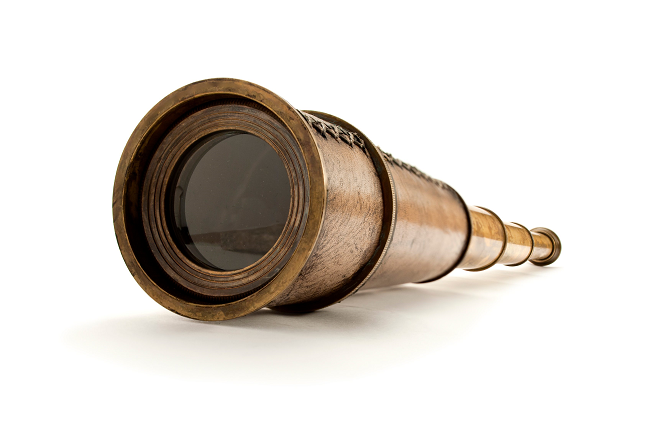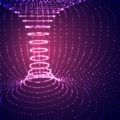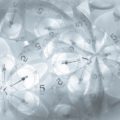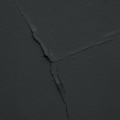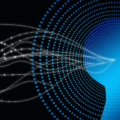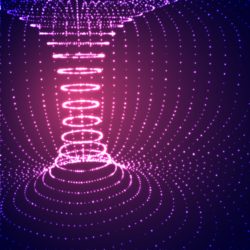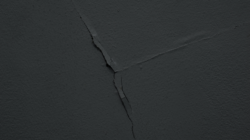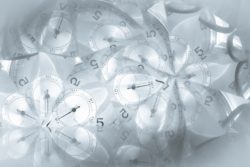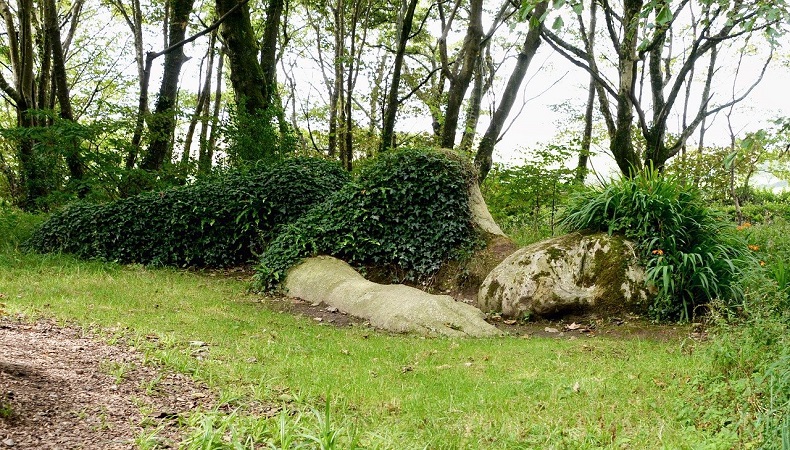Cosmologist Carl Sagan describes an interesting thought experiment called Flatland as a way to demonstrate the limits of perception. How would we perceive a 3D image if we ourselves were only 2D?
Similarly, I wonder if our sight could be circumscribed, and if the limits of perception might play a role in disease.
Imagine you are inside an arrow of time. Like the hollow of a ship’s spyglass, your perspective is confined to a limited sightline. Because this is the only reality you have ever known, you don’t realize that your perspective is bounded and you see only partially.
You can look from the small end of the spyglass to the large end. When you do, you say: Look how large the sun is! You can look from the large end of the spyglass to the small end. When you do, you say: Look how small the moon is! You do not realize that what you are seeing is a product of where you are seeing it from.
Now imagine light as like a green fabric comprised of blue and yellow fibers. When the blue and yellow fibers are dispersed evenly, homogenously, the image we see is green. But there are other ways “green” can be rendered.
If we pull all the blue fibers to the center, the background becomes yellow. The image is still green, but to see it as green, we would have to be outside the background and inside the foreground.
If we pull all the yellow fibers to the periphery, the center becomes blue. The image is still green, but again, to see it as green, we would have to be outside the background and inside the foreground. These are two different methods of creating the same image; all that changes is the foregrounding.
How can we see a blue image and a yellow image as adding up to green? Perhaps, in order to see light as it truly is, we need two observers. One who is below its speed, and another that is above it.
Ever since James Clerk Maxwell, we have treated the speed of light as a fixed number. What happens if we treat it as a scalable relationship?
Incomplete Calculations
I have written previously of the possibility that we are living in a holographic universe. Stephen Hawking, among others, believed the nature of reality might be holographic, and substantial evidence of a holographic universe was discovered in 2017.
What if light is like a plasma, something that has a dual character. Light can be “green”—light, but it can also be “blue inside yellow”—matter inside energy. Or it can be “yellow inside blue”—energy inside matter. Or, in iterative fashion, it can be yellow inside blue inside yellow inside blue … .
If we treat the moon as the moon, our calculations will be incomplete. We have to look at the moon inside the sun.
If we treat the sun as the sun, our calculations will be incomplete. We have to look at the sun inside the moon.
The planet Venus inside the planet Jupiter—or vice-versa.
The planet Mercury inside the planet Saturn—or vice-versa.
The planet earth inside the black hole—or vice-versa.
Remember, in this model, we are allowing for the possibility that we see partially—as if inside an arrow of time, or through a ship’s spyglass. We see, as it were, along a single spoke that connects an outer and an inner wheel.
The Man in the Moon
As with the universe, so with our bodies. Is this a holographic universe? I don’t know, but if it is, if light is the warp and woof of reality, it is our warp and woof.
Perhaps what we see is a static image, frozen, like a photo negative. We see something static—but time is not static. We see the sodium that sits outside the cell—not the sodium inside the cell, pushing out. We see the potassium that sits inside the cell—not the potassium outside the cell, pushing in.
I have to maintain pH7, but I can achieve pH7 in different ways.
I can condense, by pushing potassium outside the cell. You still see “net” pH7, but, actually, now I am sodium inside potassium, like the moon inside the sun. (Parkinson’s?)
I can expand, by pulling sodium inside the cell. You still see “net” pH7, but, actually, now I am sodium around potassium, like the sun around the moon. (ALS?)
The boundary itself does not move. It is I, who, as in circadian flux, can dip below or rise above it. When I dip below or rise above it, however, I create a subsequent reaction, and that reaction is what we are observing, not the thing itself.
If I pull too much sodium inside the cell, I need to contract if I wish to return to equilibrium. But how can I contract though if all my extracellular sodium is now inside the cell? I have lost my lever. I can still use my sodium to contract, but it is on the wrong side of the boundary now, and when I do, the center collapses.
If I push too much potassium outside the cell, I need to expand if I wish to return to equilibrium, but how can I expand if I have lost my intracellular potassium? Once again, I have lost my lever. I can still use my potassium to expand, but it is on the wrong side of the boundary now, and when I do, the periphery explodes.
In Parkinson’s, I have lost my ceiling.
In ALS, I have lost my floor.
For potassium, sodium is the ceiling.
For sodium, potassium is the floor.
If too much of my potassium is outside the cell, I am too far backward in time; I am at the base of the spyglass.
If too much of my sodium is inside the cell, I am too far forward in time; I am at the apex of the spyglass.
There is another way I can get into trouble—the reverse route. If I expand past the upper limit of time’s arrow, I find myself at the bottom. If I condense past the lower limit, I find myself at the top. I believe this effect, known as quantum tunneling, is what we are seeing in the fourth state of matter experiment.
If I am too much sodium and the world is too much potassium, the proton gradient, the “energy slant” between self and world is still technically right, but both sides are wrong.
In a manner of speaking, the background should be “green” (earth). If I make the background yellow (sun), I have to be blue (moon)—if I make the background potassium, I have to be sodium. If I make the background sodium, I have to be potassium. Taken together, the background and I must net to pH7.
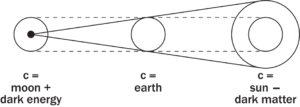
In this model, time is like a width of light, a degree of dilation. If I dilate too much, I am forced to use intracellular sodium (dark matter) to fill the vacuum. If I contract too much, I am forced to use extracellular potassium (dark energy) to fill the vacuum. In the former, now I am seeing light from matter’s perspective (ME/CFS?), while in the latter, now I am seeing light from energy’s perspective (Autism?).
For matter to approach the speed of light requires an incredible amount of speed. For energy to approach the speed of light requires and incredible amount of restraint. For light to approach the speed of light requires nothing. It is in this way that we are re-envisioning Maxwell’s equations. The images we see at the tip and the base of the spyglass are symbols. “Moon” represents matter, “earth” represents light, and “sun” represents energy.
When sodium and potassium are the same size, are superimposed, what we see is light. Earth.
By pushing potassium outside, I am left with sodium inside. It is as if I have “made” matter.
By pulling sodium inside, I am left with potassium outside. It is as if I have “made” energy.
Light itself, the substrate of the holographic universe, is the same—the information is the same. What changes is akin to the effect of foregrounding and backgrounding.
And, as with the effect of foregrounding and backgrounding, we introduce a new variable: scale.
If we push potassium outside, what remains is the same image, but the size is too small.
If we pull sodium inside, what results is the same image, but the size is too large.
Are you following? When the background (the observer) is light, the image is the right size. If the background (the observer) is matter, sodium, the observer will be too small relative to the image. If the background (the observer) is energy, potassium, the observer will be too large relative to the image. The pH of the brain is important.
Seeing Beyond the Cave Walls
We have agreed, as a society, to practice evidence-based medicine. We want to be measured, cautious, and to first do no harm. Ideas are great. Indeed, the formulation of ideas—hypotheses born of observation—is the first step of the scientific method. Ideas are great, but evidence is better.
Do we have any evidence to support this spyglass theory? We are speaking, essentially, of a scale for time, and we ourselves are part of time, so it might be tricky. How do we prove that we see as if through a spyglass if everything we see is through a spyglass? This, of course, was Plato’s famous question, and is the idea at the heart of his Allegory of the Cave. To see “outside the system” would, admittedly, be difficult, but human beings are intrepid, curious, and smart. Surely somehow, somewhere, there must be an outlier. Let’s find it.
Wait a minute. Look at this. Here is a skeleton from the Atacama Desert region of Chile. She is human, but she looks too small to us; it is as if her scale is off. Perhaps we are not seeing her through the right lens.
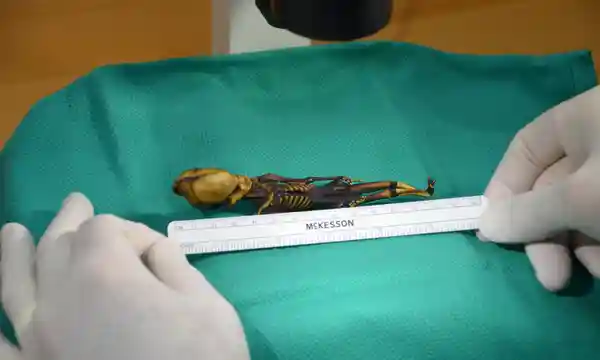
Who is the observer of Venus? Earth is not Venus’s observer. Jupiter is the observer of Venus—and Venus is the observer of Jupiter.
Who is “the observer” of Atacama? The region of the world from which she hails has something very interesting going on. In the South Atlantic Anomaly, the earth’s Van Allen radiation belt comes closest to earth’s surface, at points dipping as low as 200 kilometers above sea level. This is a dramatic difference, as you can see from this image. In this part of the world, the background might read differently to our brains—not as light, but as energy.
We are seeing Atacama out of context. We see her material body, not the energetic fabric against which it exists. In a sense, we see her, not her halo.
All the Light We Cannot See
This essay, which is part of a series, is not about object as object. It is about a way of seeing.
I can make a sodium image different ways. I can pull sodium in or I can push potassium out. What if certain regions of my body are pulling sodium in, while other regions are pushing potassium out? Then I am out of sync with myself, and I have what appears to be—on the surface—“cells behaving badly.”
Microscope Imaging Station Cancer Cells Behaving Badly
When we reach the speed of light, we have reached the limit of our expansion; we can no longer pull sodium in. Now, if we want to make sodium, we have to push potassium out. In a sense, it is the same gesture; it is only our perception that flips. When we pull sodium in, the universe expands. When we push potassium out, the observer contracts.
We are used to thinking in terms of eggs or chickens. We need to think in terms of chickeneggs. Light is a chickenegg. It can go either way. Matter is the seed within the fruit. Energy is the fruit within the seed. Light is the flower.
What we are talking about is a scalable relationship, à la Fibonacci. Matter (moon) is too small. The black hole (sun) is too large. Light (earth) is just right. OR Matter (moon) is too small. The black hole (earth) is too large. Light (the 37th parallel) is just right. And so on.
When the background is light, light can be light. When the background is matter, light has to be energy. When the background is energy, light can be matter.
Reality: Fission and Fusion
When earth is the moon, I have to be the sun—to split from myself, as I move forward in time.
When earth is the sun, I get to be the moon—to reunite with myself, as I move forward in time.
The density of the moon (collapsing force) is what creates the sun’s heat. Like moving the blue fibers to the center of the cloth creates a yellow background. OR The heat of the sun (expanding force) is what creates the moon’s density. Like moving the yellow fibers to the perimeter of the cloth creates a blue foreground.
When I pull blue to the center, I create a yellow background. OR When I stretch yellow to the periphery, I create a blue foreground. These result in the same overall picture, but the forces—and the foregrounded image—are not the same.
My mother (Alzheimer’s) seems to have a problem at sundown. It is as if she can pool her blue, but she cannot stretch her yellow.
If we push all the blue fibers to the periphery, the center looks yellow. But beyond the periphery looks yellow, too. If I am trying to match yellow’s speed, which yellow is it? Little yellow, or big yellow?
What We Call the Moon
Have we been reading the cosmos all wrong? This video—“Why No One Has Measured the Speed of Light”—has 18 million views for a reason. The speed of light is a round-trip measurement. We don’t see light that goes to the moon; we see light that goes to the moon and back.
Let us try seeing the opening of this essay a different way. When we look from the large end of the spyglass to the small end, we say: Look how hot the moon is! When we look from the small end of the spyglass to the large end, we say: Look how cold the sun is! We do not realize that what we are seeing is a product of where we are seeing it from.

If I can—internally—ease off the intracellular sodium, and—externally—ease off the extracellular potassium, I can achieve the same homeostasis in a way that is much less expensive.
Two forces are in balance when they are both zero. Two forces are also in balance when they are both very high.
At the tip of time’s arrow, although you can’t see it, I am in a state of subclinical hypertension. When my frame of reference is too narrow, time will seem too wide. When time is too wide, I will over-utilize intracellular sodium, to fill the vacuum. To appreciate the vaso-constricting force I am applying, you would have to feel the exploding force I feel. At the tip of the spyglass, I have reached the speed of light. I am so constricted that to constrict further would cause me to split into other worlds.

At the base of time’s arrow, although you can’t see it, I am in a state of subclinical hypotension. When my frame of reference is too wide, time will seem too narrow. When time is too narrow, I will over-utilize extracellular potassium, to fill the vacuum. To appreciate the vaso-dilating force I am applying, you would have to feel the condensing force I feel. At the base of the spyglass, I have reached the speed of light. I am so dilated that to dilate further would be to admit other worlds.
At both the base and the tip, the limit is the same width. At the base (sun), I cannot dilate wider than the present (earth). At the tip (moon), I cannot constrict narrower than the present (earth).
In these models, “now” is a width of light. The past is too narrow. The future is too wide.
From the middle of the spyglass, I can dilate as wide as the sun. But here’s the problem: I don’t have the sun’s dark matter (intracellular sodium).
From the middle of the spyglass, I can constrict as narrow as the moon. Again, there is a problem: I don’t have the moon’s dark energy (extracellular potassium).
I have to be able to move forward and backward – to squeeze and to dilate. At the tip of time’s arrow, I am fully squeezed—I can only dilate. At the base of time’s arrow, I am fully dilated—I can only squeeze. I am limited as a bellows is limited.
If my understanding of time’s arrow is off, instead of being between the floor and ceiling, I am both “outside the background and inside the foreground.” This means I have to inhale from a totally compressed position, then exhale from a totally dilated position. It’s like having sleep apnea all the time.
When some of my light is outside time’s spyglass—when it is “freezing and scorching” at the same time—I have cancer.
All that is required, in order for light to function as light, is to establish a floor and a ceiling. In cancer, I have done so—at a smaller scale.
Psychedelics and Time
If my pipe is too wide, I can make wider red blood cells to create peripheral resistance and try to regain autonomic control, but this takes time (120 days), and by the time I make a whole new set of blood, will the pipe be too wide again? We are seeing blood cell changes in Long COVID. When the pipe is too wide, my blood pressure is like a runaway train. When I squeeze, there is nothing squeezing back. Sadly, vasodilators, such as niacin, will only make me worse. It is because the background feels too wide that I am keeping the pressure too high. Yet to vasoconstrict while the pressure is too high is dangerous, and could lead to a stroke, heart attack, or heart damage. At the tip of time’s arrow, I find myself in a metabolic cul-de-sac. I write more about metabolic gridlock here.
Biologically, the atomic oscillation rate of cesium does not feel like the best metric to measure time. In me, time feels restricted by the rate—the upper and lower limit—of heme synthesis.
There has to be contradiction. Resistance. Often I use what you give me paradoxically. When you give me a brake pedal, it gives me permission to accelerate—because now I know I can slow down.
This world is not a vacuum. It is a world of opposing forces. Just because we cannot see them—because they net to zero—does not mean they are not there. Time has a floor and a ceiling. I need to feel them; I need a wall to repel against. When I am too wide and time is too wide, I get a migraine. A small dose of psychedelics, or caffeine, can provide the vasoconstriction I cannot provide for myself, and make the migraine go away.
There is another way to think about the origins of time. The *information* is constant. Each time it is compressed all the way (Big Bang), it begins to expand all the way. The laws of physics—the code, the DNA—are the same. What changes are the effects of free will. In some universe, Nelson Mandela died in prison. In another universe, the July Plot to Kill Hitler succeeded; Anne Frank is alive today and has written many books and has many children and great-grandchildren who all call her Oma. In another universe, the angle of the car crash was different; Princess Diana is alive today and walks with a cane. A universe is a loop of time. The holographic boundary or “end of time” (the speed of light) is the end from which we start. We can eclipse the speed of light—by using intracellular sodium. Or we can dip below the speed of light—by using extracellular potassium. But the speed of light is the natural state, and we should use it as the baseline in our equations.
Additional Resources
The Speed of Time in Health and Disease
Holographic Universe Theory and Health and Disease
Parting the Veil on pH and Metabolism
Hidden Variables in Disease: Spin and Scale
Holographic Universe: Implications for Cancer, Parkinson’s, ALS, Autism, ME/CFS
We Need Your Help
More people than ever are reading Hormones Matter, a testament to the need for independent voices in health and medicine. We are not funded and accept limited advertising. Unlike many health sites, we don’t force you to purchase a subscription. We believe health information should be open to all. If you read Hormones Matter, like it, please help support it. Contribute now.
Yes, I would like to support Hormones Matter.
Feature Image: iStock image 135755878.
